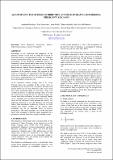| dc.contributor.author | Davidson, Jonathan | |
| dc.contributor.author | Siratovich, Paul | |
| dc.contributor.author | Wallis, Irene | |
| dc.contributor.author | Gravley, Darren | |
| dc.contributor.author | McNamara, David D. | |
| dc.date.accessioned | 2017-08-11T11:29:34Z | |
| dc.date.available | 2017-08-11T11:29:34Z | |
| dc.date.issued | 2012 | |
| dc.identifier.citation | Davidson, Jonathan , Siratovich, Paul , Wallis, Irene , Gravley, Darren, & McNamara, David D. (2012). Quantifying the stress distribution at the Rotokawa Geothermal Field, New Zealand. Paper presented at the New Zealand Geothermal Workshop, Auckland. | en_IE |
| dc.identifier.uri | http://hdl.handle.net/10379/6705 | |
| dc.description.abstract | Knowledge of the orientation and magnitude of the principal stresses can be used to model the behavior of faults and fractures, and determine how they may influence fracture hosted permeability in geothermal reservoirs. The permeability of the Rotokawa geothermal reservoir is dominantly fracture hosted and tectonic stresses are largely responsible for maintaining fluid flow in the reservoir. Reactivation of a fault or fracture depends on its orientation relative to the orientation of the stress field and the magnitude of the principle stresses. The purpose of this study is to determine the magnitude of the three principal stress axes at Rotokawa, and how they vary spatially. This will help our understanding of the distribution of fracture-hosted permeability in the reservoir. In the extensional tectonic settings, such as the Taupo Volcanic Zone, the magnitude of the vertical stress is dominated by the weight of the overburden. Previous rock density studies on core from Rotokawa wells and on rock from other geothermal fields are used here, along with variable thicknesses of different geologic units, to model the vertical stress. Leak-off tests and acoustic images that contain stress induced features are used to quantify aspects of the minimum and maximum horizontal stresses. We show that the differential stress between the vertical and minimum horizontal is near the threshold for frictional failure. More importantly, preliminary results of our study indicate that spatial variation in the vertical stress magnitude may be an important factor in fracture permeability. This study highlights some of the difficulties faced when attempting to estimate stress magnitudes in a geothermal reservoir hosted in a complex volcanic terrain. | en_IE |
| dc.format | application/pdf | en_IE |
| dc.language.iso | en | en_IE |
| dc.publisher | New Zealand Geothermal Workshop | en_IE |
| dc.relation.ispartof | New Zealand Geothermal Workshop 2012 | en |
| dc.rights | Attribution-NonCommercial-NoDerivs 3.0 Ireland | |
| dc.rights.uri | https://creativecommons.org/licenses/by-nc-nd/3.0/ie/ | |
| dc.subject | Stress magnitude | en_IE |
| dc.subject | Overburden | en_IE |
| dc.subject | Density | en_IE |
| dc.subject | Differential loading | en_IE |
| dc.subject | Fracture permeability | en_IE |
| dc.title | Quantifying the stress distribution at the Rotokawa Geothermal Field, New Zealand | en_IE |
| dc.type | Conference Paper | en_IE |
| dc.date.updated | 2017-07-22T12:06:46Z | |
| dc.local.publishedsource | https://www.geothermal-energy.org/publications_and_services/conference_paper_database.html | en_IE |
| dc.description.peer-reviewed | peer-reviewed | |
| dc.contributor.funder | |~| | |
| dc.internal.rssid | 11992032 | |
| dc.local.contact | David Mcnamara, -. - Email: david.d.mcnamara@nuigalway.ie | |
| dc.local.copyrightchecked | Yes | |
| dc.local.version | PUBLISHED | |
| nui.item.downloads | 290 | |


